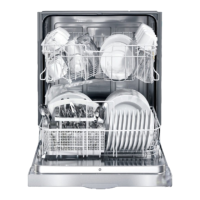
Do you have a question about the Miele G 2182 and is the answer not in the manual?
| Brand | Miele |
|---|---|
| Model | G 2182 |
| Category | Dishwasher |
| Language | English |
Provides a visual guide to the main components of the dishwasher, including baskets and spray arms.
Details the buttons, indicators, and layout of the dishwasher's control interface for operation.
Outlines crucial safety precautions and warnings regarding children's interaction with the dishwasher.
Specifies the intended use of the dishwasher and limitations for safe operation.
Covers essential safety measures related to electrical connections, installation, and potential hazards.
Provides guidelines for correctly installing the dishwasher to ensure stable and safe operation.
Details guidelines for safe and proper usage, including what not to do with the appliance.
Information about using genuine Miele spare parts and accessories for safety and warranty.
Instructions on how to safely and responsibly dispose of an old dishwasher appliance.
Guidance on environmentally friendly disposal and recycling of the dishwasher's packaging materials.
Instructions for the proper disposal of the old dishwasher unit, emphasizing environmental responsibility.
Tips and advice on how to operate the dishwasher efficiently to save energy and water.
Step-by-step instructions on how to properly open the dishwasher door.
Step-by-step instructions on how to properly close the dishwasher door.
Explains the function of the water softener and the importance of using soft water for optimal cleaning.
Detailed instructions on how to set the dishwasher's water hardness level for best performance.
Guide on how to verify the currently set water hardness level on the dishwasher.
Lists essential items and preparations needed before operating the dishwasher for the initial use.
Instructions on how to correctly fill the salt reservoir for the water softener.
Explains the function of the salt indicator light and when to refill the salt reservoir.
Explains the purpose of rinse aid and how it aids drying and prevents spots.
Provides instructions on how to open the rinse aid reservoir and add rinse aid.
Describes the rinse aid indicator light and when to add more rinse aid.
Guide on adjusting the amount of rinse aid dispensed for optimal washing results.
General notes and important considerations for loading crockery, including pre-rinsing and item placement.
Lists types of items and materials that should not be washed in the dishwasher due to potential damage.
Instructions for loading items into the upper basket, including cups, glasses, and shallow pans.
Details on how to use the hinged cup rack to accommodate tall items.
Explains how to use the positioning rail for supporting glasses.
Describes the use of the universal support for securely holding tall glasses with stems.
Instructions on how to adjust the height of the upper basket to optimize space for crockery.
Information on plate dimensions that fit in the upper and lower baskets when using a cutlery tray.
Information on plate dimensions that fit in the upper and lower baskets when using a cutlery basket.
Guidance on loading larger and heavier items into the lower basket, such as plates and pots.
Details on using the hinged spikes for washing plates and saucers.
Instructions for removing and replacing the spiked insert to accommodate larger items.
Explains how to use the bottle holder for washing narrow items like baby bottles.
General information about loading cutlery efficiently.
Instructions for arranging cutlery in the cutlery tray for optimal cleaning.
Guidance on loading cutlery into the cutlery basket for better cleaning and drying.
Instructions for using the insert for cutlery baskets, especially for heavily soiled spoons.
Information on types of detergents, active ingredients, and recommended usage for dishwashers.
Step-by-step instructions on how to correctly dispense detergent into the dishwasher's dispenser.
Steps for powering on the dishwasher, including checking water supply and spray arms.
Guidance on choosing the appropriate wash programme based on load and soiling.
Instructions on how to initiate a selected wash programme on the dishwasher.
How to check if a programme has finished and precautions regarding steam release.
Steps for turning off the dishwasher after a programme has completed.
Advice on unloading dishes safely, considering heat, and the correct order of unloading baskets.
Information on how to pause and resume a running programme, including safety warnings.
Steps to follow if you need to change the selected programme after it has started.
Explains the buzzer function, its sounds for programme end or faults, and how to deactivate it.
Instructions on how to reset all user-altered settings back to the original factory defaults.
How to clean the dishwasher's door and its seals to remove food deposits.
Guidance on maintaining the interior wash cabinet, including removing limescale and grease deposits.
Instructions for cleaning the control panel and outer door front safely, avoiding damage.
Detailed steps for removing and cleaning the filter combination in the dishwasher's wash cabinet.
How to inspect and clean the dishwasher's spray arms to ensure optimal water jet performance.
A guide to diagnosing and resolving common technical issues with the dishwasher.
Troubleshooting steps for problems related to the dishwasher's water intake or drainage system.
Solutions for common operational issues not related to specific technical faults.
Identifies common noises and their causes, providing solutions for resolving them.
Advice for troubleshooting issues leading to dishes not being clean or having smearing.
Troubleshooting tips when dishes, cutlery, or glasses are not drying properly or have spots.
Solutions for issues causing white residue, clouding, or films on tableware.
Addresses issues causing discolouration or persistent films on glassware.
Solutions for stubborn stains like tea or lipstick that remain after washing.
Explains causes of discolouration in plastic items and potential remedies.
Addresses the issue of rust stains appearing on cutlery and their potential causes.
Step-by-step guide to cleaning the water inlet filter to ensure adequate water flow.
Instructions for cleaning the drain pump and non-return valve to resolve drainage issues.
Categorizes crockery types and their typical food deposits to guide programme selection.
Describes different types of food deposits and their impact on washing requirements.
Recommends appropriate wash programmes based on crockery type and food deposit levels.
Lists available wash programmes with their corresponding temperature and detergent requirements.
Details the detergent requirements for each programme, specifying compartments and quantities.
Outlines the sequence of operations within each wash programme, including rinses and drying.
Provides data on energy and water consumption for different programmes and connection types.
Lists the estimated duration for each programme under various connection conditions.
Information on how to contact Miele for repairs and service assistance.
Details on the programme update function for enhancing appliance electronics.
Information for testing institutes regarding comparison tests and noise level measurements.
Safety and procedural guidelines for electrical connections specific to the UK market.
Information regarding the proper handling and replacement of fuses for BS 1363 plugs.
Explains the function and benefits of the Miele waterproof anti-leak system for preventing water damage.
Details on connecting the dishwasher to the water supply, including pressure and hose requirements.
Guidelines for the dishwasher's drainage system, including hose length and connection points.
Instructions on how to vent the drainage system to prevent siphoning effects.











